Remembrance Day has just past so in this week’s arcs & runs we will take a look at the first six issues of Marvel’s World War II comic title Sgt. Fury and his Howling Commandos.
War comics were very popular during the second world war and got a second wind of popularity all through the 1950’s. This might strike some readers here as a bit odd given that you would have thought most people would be sick of war, and anything to do with it. I would dare say that initially when most of the fellas got back home they were thinking of something else (note “the baby boom”). They did get back to comics though and War comics like Two Fisted Tales, Our Army at War, G.I. Combat, and Star – Spangled War Stories were very popular throughout the 50’s with veterans and teens alike. The Sgt. Rock and Sgt. Fury titles were a big deal on into the 60’s before the whole genre lost steam in the late 70’s and more or less disappeared.
Sgt. Fury was certainly a late comer to the party. It did help that the man behind the pencil and I suspect most of the plot and words was one Jack Kirby. Private Jacob Kurtzberg (Jack’s real name) was drafted into the army in June 1943 and saw action (tanks vs infantry yikes!) against the Nazis in the fall of 1944. Jack had experienced life in the trenches, and the close-knit comradery of working with guys in a high-pressure scenario with your life in the balance. Bonds and memories formed in these situations don’t fade easily. I thought Mr. Kirby captured the sense of comradery within the Howlers really well, and the almost family type bond that forms within an army unit.
Art by Jacky Kirby. Inking by Dick Ayers and George Roussos. Stories by Stan Lee.
And away we go – Wah-hoo!!
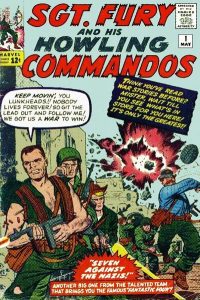 Sgt. Fury #1
Sgt. Fury #1
Seven against the Nazis
May 1963
As anyone/everyone who reads the Undervalued Spotlight now knows Walt and I don’t consult each other before we write our columns. Young Walter wrote about the many financial virtues of this book in his last UV Spotlight. We will now get to the highlights of the rest of this book. It is primarily an introduction story to our featured cast. We are introduced for the first time to Sgt. Nick Fury, Corporal Dum Dum Dugan, Gabriel Jones, Robert “Rebel” Rolston, Izzy Cohen, Dino Manelli, and Jonathan “Junior” Juniper. The team of seven is careful to include and represent many ethnic groups and regions of the United States. It is a tried and true formula that has worked in the movies for years, and it worked here as well. The team is based in England and get their marching orders from Captain “Sad” Sam Sawyer. There does not appear to be any close chronological time references to the books storylines bouncing back and forth thru 1944 to 1943 and back again. No one really is keeping score on that front. Typical early stories have the team working with the French resistance battling the Nazis.
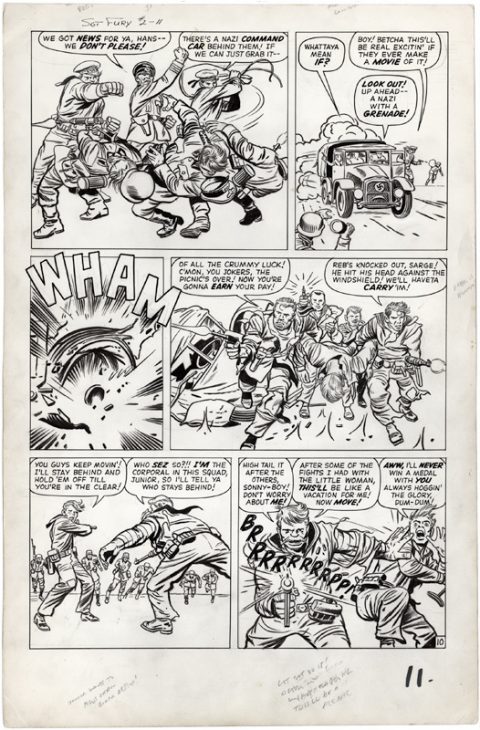
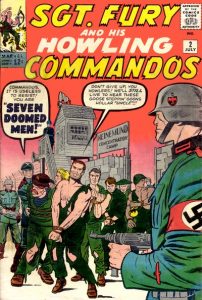 Sgt. Fury #2
Sgt. Fury #2
7 Doomed Men
July 1963
The team takes on heavy water experiments and V2 rockets with the help of the French resistance. I have always liked this book but never owned it. I did own a mint copy of Sgt Fury #95 which is the reprint. The damn black box picture frame cover won out. All of these stories have pin-up pages following the main story of weapons used in the second world war.
Sgt. Fury #3
Midnight at Massacre Mountain
September 1963
This issue is famous for the appearance of a young OSS officer named Major Reed Richards. Marvel usually finds a way to integrate its characters into other books and keep them in the tightknit Marvel Universe. This is a bit of a stretch, but it worked and Nick Fury predicts a bright future for the brave young Richards. The Howlers rescue a trapped group of soldiers and also dispose a Waffen SS traitor (Hans Smith). All in a day’s work.
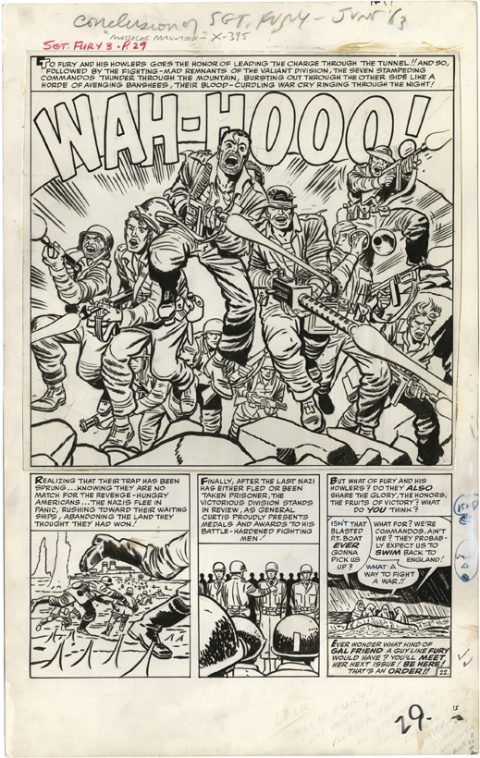
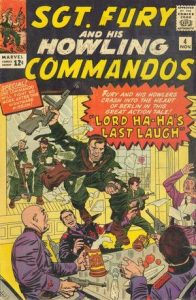 Sgt. Fury #4
Sgt. Fury #4
Lord Ha Ha’s Last Laugh
November 1963
This book features the death of young Junior Juniper the youngest Howler and the only one to be permanently bumped off. It had quite the impact at the time. It is not like today where a good or bad guy can seemingly come back from almost any death. I thought Stan Lee made a mistake when he made Nick Fury the director of Shield in Strange Tales #135. This was the same time-frame as Sgt. Fury #21 and made him, Dum Dum Dugan, and Gabriel Jones invincible in every storyline. This left guest stars and the lesser Howlers on the block. In issue #4 it is a guest-star as we are introduced to the tragedy struck Hawley family. Percy Hawley has defected to the Nazi’s who end up killing him at the end of this episode. Pamela Hawley sister of Percy, who later becomes a love interest of Nick Fury gets killed in issue #18.
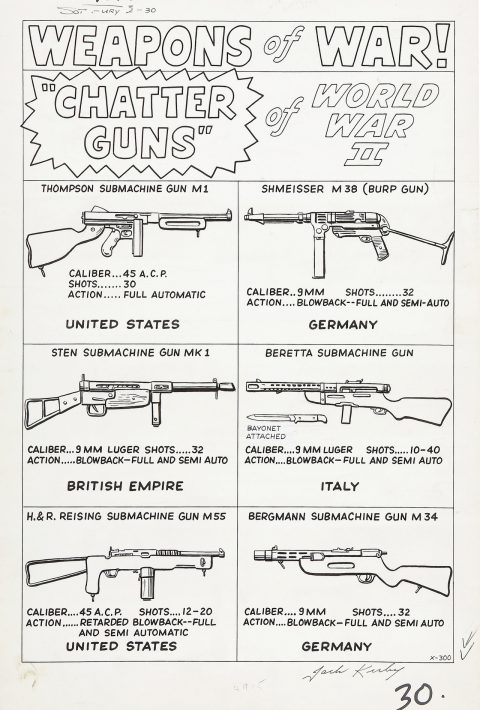
 Sgt Fury #5
Sgt Fury #5
At the mercy of Baron Strucker
January 1964
In this issue we meet Nick Fury’s arch-nemesis Baron Wolfgang von Strucker. Baron Strucker becomes his worst enemy in the second world war and beyond as the head of Hydra. Baron Strucker also tackles f Captain America and many others in the Marvel Universe. Unlike Junior Juniper he also seems to be impervious to death. In this issue he tricks Sgt. Nick Fury in to test of strength and skill in order to show the world the Howlers are not unbeatable. Nick swallows the bait and some poison wine too, which leaves him very beatable for the Baron. A propaganda tape is made of his “battle” and this is shown for all to see. Ashamed Nick Fury attacks Baron Strucker against orders on his own terms. He of course wins this round and the battle continues to this day.
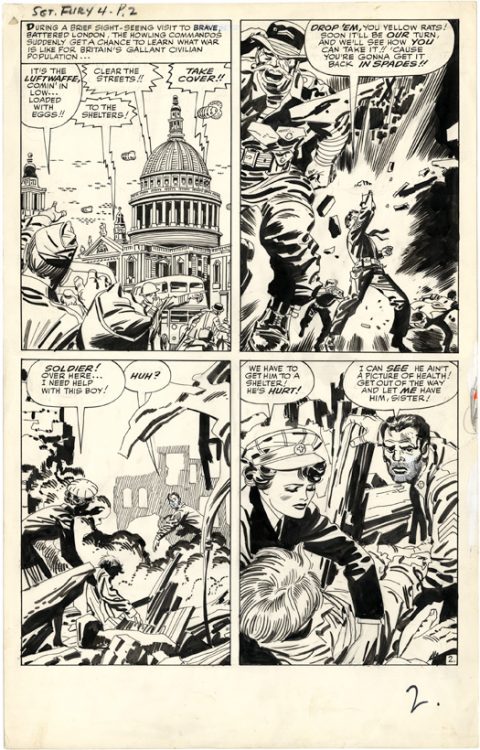
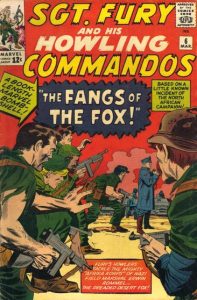 Sgt. Fury #6
Sgt. Fury #6
Fangs of the Desert Fox March
1964
In the final issue of this post the Howlers travel to Africa to battle/assassinate General Erwin Rommel. Rommel was known as the Desert Fox and was a shrewd tank commander and a major thorn in the side of the brits in Africa and the battle for oil. Rommel was probably the most respected general in the German army from the allies’ perspective. He was seen as a loyal German and not a Nazi. This issue also attacks racism and no-count soldering with the introduction of guest star George Stonewall. The Howlers were only stuck with this guy for one issue, and by the end of the book we are glad he has been transferred. A solid story and good read.
Sgt. Fury ran from May 1963 thru to December 1981, one hundred and sixty-seven issues and seven annuals.
Reprint note: Between issues #80 and #120 there are large number of reprint books in this particular run that are not noted in Overstreet and there is no change in valuation between the reprints and original stories. For the record here are the reprint issues #80, #82, #85, #87, #89, #91, #93, #95, #101, #103, #105, #107, #109, #111, #113. The last issue with original material is #120, issue #121-167 are all reprints. If you are looking for some of the early Sgt. Fury reprints check-out Special Marvel Edition #5-14. Sgt. Fury #13 the Captain America crossover is re-printed in Special Marvel Edition #11 and is a great way to get the story in comic form – cheap.
The 47th Overstreet Price guide values for the books reviewed today are listed below.
| 6.0 | 8.0 | 9.0 | 9.2 | |
| Sgt Fury #1 | $1200 | $3400 | $7700 | $12000 |
| Sgt. Fury #2 | $171 | $456 | $1028 | $1800 |
| Sgt. Fury #3-5 | $90 | $216 | $483 | $750 |
| Sgt. Fury #6 | $48 | $110 | $243 | $375 |
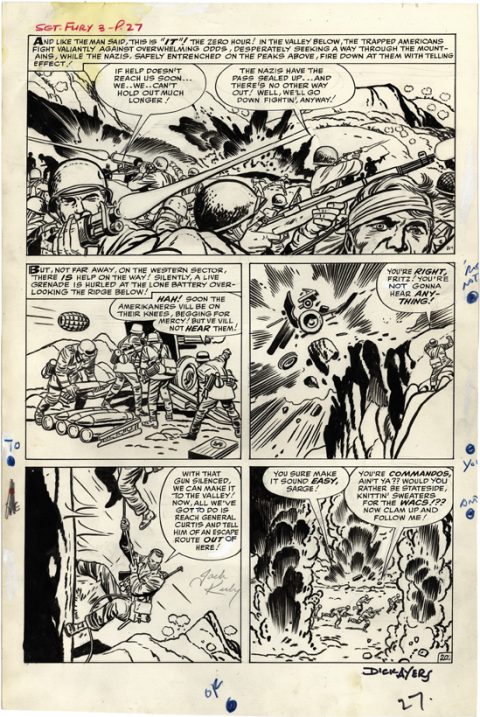
As I noted at the top of the post Remembrance Day passed by here on November 11th. I wanted to share a war story from a man and World War Two vet I got to know over the years and has since passed on. It is a story that will stick with me for the rest of my days.
I met Mike or Mr. B years ago at family functions, he was my brother-in-law’s father. Mr. B was a big, quiet, affable man, six foot four inches with wide sloping shoulders, and in his late seventies. At one summer picnic at his place I noticed a small war picture sitting on a mantle in his living room. I looked a little closer and my jaw nearly dropped. It was Mr. B and the medal was being placed on him by British Brigadier General George Montgomery (a very big deal in World War Two). It was a medal for bravery, I can’t remember what it was called. I track down Mr. B with a paper plate full of food and ask him about the photo. You never know what kind of response you will get when you ask a war veteran about their war experiences. Most don’t want to talk about it all. It does help if you know at least a little bit about it, which I do and Mr. B settled down into a ham sandwich and deviled eggs and told his story.
Mr. B was pinned down with his unit on D-Day at Juno Beach. They were up against a hill under heavy fire from the Germans. An explosion took place right beside him. He turned, cleared the sand of his helmet, and looked beside him where a couple of his best friends had been. Gone – nothing but a big black hole in the ground remained. Mr. B started shaking with anger grabbed a big machine gun and started running and screaming up the hill. He told me he didn’t think he could run so fast – especially through sand. At six/four back in the 40’s Mr. B was a big target and yet somehow made it to the top of the hill unscathed, and still firing his machine gun. There was a pill-box on the top of the hill and the turrets were pointing away from him. He ran straight toward it still shooting and screaming. The turret began to turn toward him also still firing. That was the last thing he could remember before waking up in an army hospital.
When Mr. B woke up his arms were in slings, and his upper chest in a cast. He had been in hospital for some time, he couldn’t recall how long. The German turret had shot him twice – once below each shoulder blade, apparently not hitting a bone! The big news was he was a hero. He didn’t know why, so he was told. While Mr. B was running like a crazy person up the hill about twenty other soldiers followed his charge up the hill. They over-ran the pill box and the position and established a route for others to follow up and off the beach. Mr. B couldn’t believe it. There was a parade for him and another fellow from his hometown upon his return. I asked Mr. B what he done with his medals, and he said they were up in the attic, in a box collecting dust. He felt funny about the medals. To him all they represented was a reward for hate. At the time of the charge all he wanted to do was kill a German soldier, because they had killed his friends. He struggled at times with what we now call survivors guilt. Why me? Why did I make it and not others? You can’t “unsee” the horrors of that beach. Mr. B also told me he saw that big black hole almost every day of his life.
Thanks again Mr. B. You are missed.

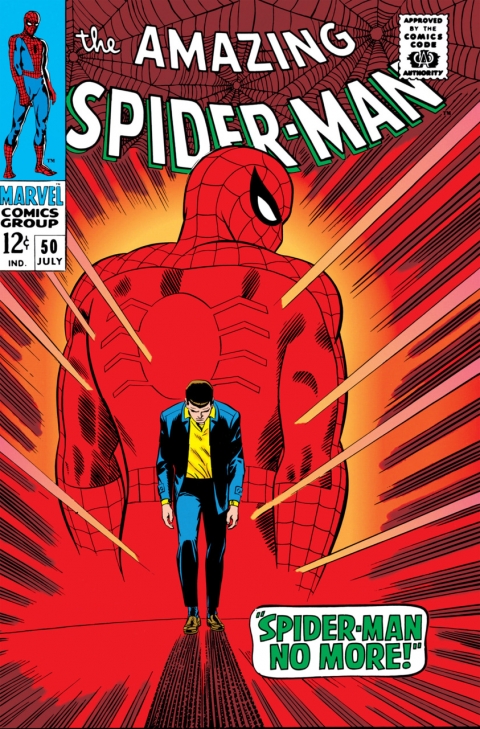
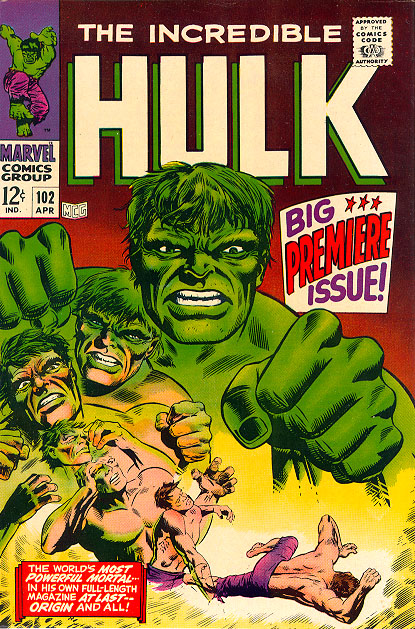
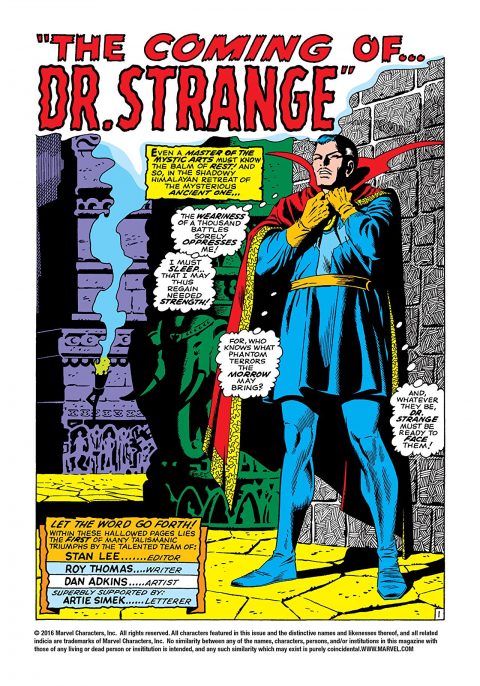
That is a wonderful story. I struggle with even liking these war books, but the Kirby Ayers work is so beautiful. I recently picked up some Tales of the Green Beret Dell books in a lot, and the covers are so racist that I think i am just going to throw them out.
Thanks for commenting Matt. I remember seeing those Tales of the Green Beret books but never got near buying them. Perhaps unfairly, the terrible John Wayne movie The Green Berets always comes to mind…. You are correct about the blatant racism on war covers. From the 1940’s on they were designed to stir up the general populace for support against our enemies. Some of them are pretty cringe worthy now.
Wonder when Overstreet is going to give Sgt. Fury #5 it’s own line listing in the guide. More important issue that usually has higher sales than #3 and #4.
I agree that many of the comic covers of the past are racist, to be sure, but I always think of them more as touchstones to a time and place that we have moved beyond and a reminder of just how far we have come in dealing with intolerance. I used to have an old Spirit section from the ’40s with the cover surrounded by images of Ebony in the most grotesquely racist caricatures you might imagine. It unnerved me, yes, but it is an amazing time capsule of attitudes in the past. A lot of romance comics are blatantly sexist, because that was the temper of the times, but we should, again, never forget how far we have come. History isn’t always pretty when it comes to our treatment of each other, but it’s still history. We have to know where we came from if we want to know what direction we’re heading.
cheers, mel
Very good point Nathan. Breaking out of a run can lead to a bit of a run-up in the price of the book.. Sounds like a good submission for Undervalued Overstreet!
Well put Mel. In terms of the direction of where we are heading as a society, we appear to have much farther to go than I used to think.